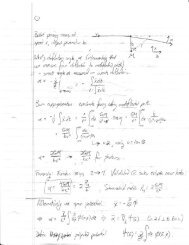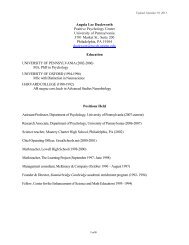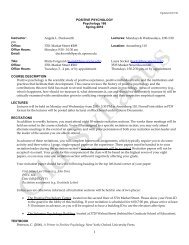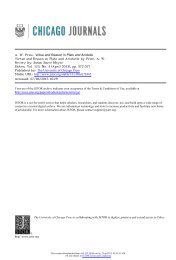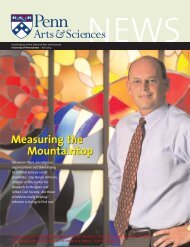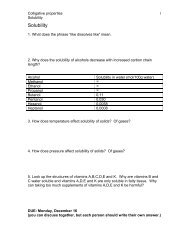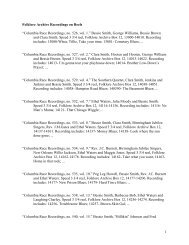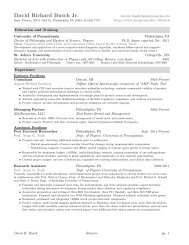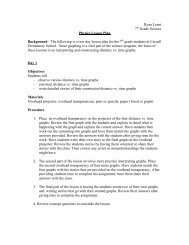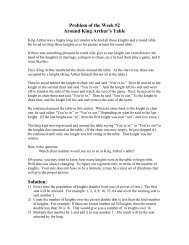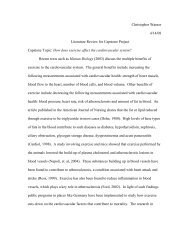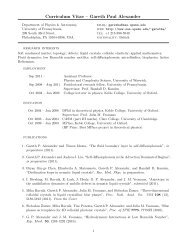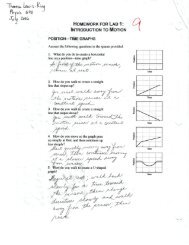Chapter 19.1 Molecules and compounds Teacher: Kenneth O ...
Chapter 19.1 Molecules and compounds Teacher: Kenneth O ...
Chapter 19.1 Molecules and compounds Teacher: Kenneth O ...
Create successful ePaper yourself
Turn your PDF publications into a flip-book with our unique Google optimized e-Paper software.
<strong>Chapter</strong> <strong>19.1</strong> <strong>Molecules</strong> <strong>and</strong> <strong>compounds</strong><br />
<strong>Teacher</strong>: <strong>Kenneth</strong> O’Rourke<br />
Subject: Physical Science<br />
Dates: 10-25-03 to 10-29-03 Time: Approx one week<br />
Topic: Chemical bonding<br />
Grade: 9 inclusion classroom<br />
Note: Intelligences- Linguistic, logical math, spatial, kinesthetic, musical, interpersonal,<br />
intrapersonal, naturalist.<br />
Per. St<strong>and</strong>ards- active learning, coherence, critical/creative thinking, real world<br />
connections, reflection, fosters underst<strong>and</strong>ing of content<br />
Objectives: Students will be able to:<br />
• Relate chemical bonding to its placement on the periodic table<br />
• Identify how chemical bonds form<br />
• Explain the role of valence electrons in the bonding process<br />
• Identify <strong>and</strong> diagram ionic <strong>and</strong> covalent bonds<br />
• To relate <strong>and</strong> identify the types of bonds used in biological processes<br />
• Discuss the importance of how each bond functions in biological processes<br />
Materials: Notebook, Textbook p.325 – 350, blackboard, computer, PowerPoint,<br />
overhead, TV, Internet, lab equipment, & calculator<br />
Vocabulary: Avogadro number, chemical bond, chemical formula, covalent bond, ionic<br />
bond, formula mass, octet rule, monatomic ion, polyatomic ion<br />
Organizational Structure: Traditional classroom setting, lab, group work<br />
Learning topic 1: Octet Rule<br />
1) Review of valence electrons<br />
2) Students calculate electron configuration<br />
3) Atoms are in their most stable state when they have 8 electrons in their outermost<br />
energy level- Students will be able to explain the connection between the noble<br />
gasses <strong>and</strong> the octet rule<br />
Learning Topic 2: Periodic table <strong>and</strong> the octet rule<br />
1) Valence electrons, orbitals, <strong>and</strong> periodic table worksheet<br />
2) Periodic table & valence electron relative game<br />
1) Students group elements according to valence electrons<br />
2) Students investigate similarities <strong>and</strong> differences within the groups<br />
Learning topic3: Types of bonds<br />
1) Bonding <strong>and</strong> molecule lab (atom building set useful for all activities) Atom<br />
building set is a model of an atom where protons, neutrons <strong>and</strong> electrons are<br />
placed in their proper places. Students can then use them to model the different<br />
kinds of chemical bonds.<br />
2) Lewis dot diagrams
a) PowerPoint<br />
b) Demonstration<br />
c) Student examples done on overhead<br />
3) Ionic bonds<br />
a) Ionic bond PowerPoint<br />
b) Special properties of ionic bonds<br />
c) Ionic bond worksheet<br />
d) Ionic bond/Lewis diagram worksheet<br />
4) Covalent bonds<br />
a) Covalent bond PowerPoint<br />
b) Special properties of covalent bonds<br />
c) Covalent bond worksheet<br />
d) Covalent bond/Lewis diagram worksheet<br />
Learning topic five: Chemical bonding in biological processes<br />
1) Introduction to sugars- (Excerpts from a pdf document found at:<br />
http://www.angelo.edu/faculty/kboudrea/index_2353/Notes_<strong>Chapter</strong>_07.pdf )<br />
Student h<strong>and</strong>out (attached) In the first part of the lesson is to have an interactive<br />
lecture (in a POGIL style) by reading the document with the students, questioning<br />
them, <strong>and</strong> answering their questions. Have the students answer the first question,<br />
go over the correct answer identifying the different bonds in the molecule. Have<br />
students answer the second question, then get a good sample of answers from the<br />
class <strong>and</strong> come up with the best working answer for the question <strong>and</strong> allow<br />
students time to amend their answer. The final question students should answer<br />
on their own <strong>and</strong> h<strong>and</strong> in for you to grade. The questions are designed to see how<br />
well the students underst<strong>and</strong> the concept of chemical bonding, <strong>and</strong> to see how<br />
well they can apply knowledge in a logical way to answer a question. Hints or<br />
cues may be needed to stimulate their thought process.<br />
2) Identifying the chemical bonds in a monosaccharide <strong>and</strong> polysaccharides (covered<br />
in question one of the h<strong>and</strong>out)<br />
3) Benefits of the types of bonds <strong>and</strong> impact on cell function (covered in question 6<br />
& 7 in the h<strong>and</strong>out)<br />
4) Students explain why covalent bonds are used in sugar formation, <strong>and</strong> why ionic<br />
bonds are not. (covered in question 6 & 7 in the h<strong>and</strong>out)<br />
5) Students build a long polysaccharide from atom building sets The atom building<br />
sets are given to each lab group to build a glucose molecule. The groups then link<br />
them into a polysaccharide chain. Each lab group needs to be supervised to insure<br />
they are making the right molecule. When the sugars are linked, make sure the<br />
water molecules are also formed. Point out to the students that the nature of<br />
covalent bonds makes it possible for living things to string large molecules<br />
together from smaller base units like bricks in a building. The size of the huge<br />
complex molecule model in your classroom should bring home the fact that very<br />
complex things are made up of simpler units, <strong>and</strong> can be understood when you see<br />
the pattern.<br />
Home Learning: Vocabulary, worksheets, lab reports, reading
Assessment:<br />
1) Question <strong>and</strong> answer sessions asking students to cite examples<br />
2) Atom building models<br />
3) Worksheets<br />
4) Biological process h<strong>and</strong>out<br />
5) Quizzes<br />
6) MOLP extra help session (one on one evaluation)<br />
7) One thing learned <strong>and</strong> one thing you don’t get. Write it down & h<strong>and</strong> in. This is<br />
helpful for the students that will not raise their h<strong>and</strong> to ask questions. You can get<br />
a good feeling as to what they underst<strong>and</strong> <strong>and</strong> what confuses them about the<br />
concept.<br />
Reflection:



